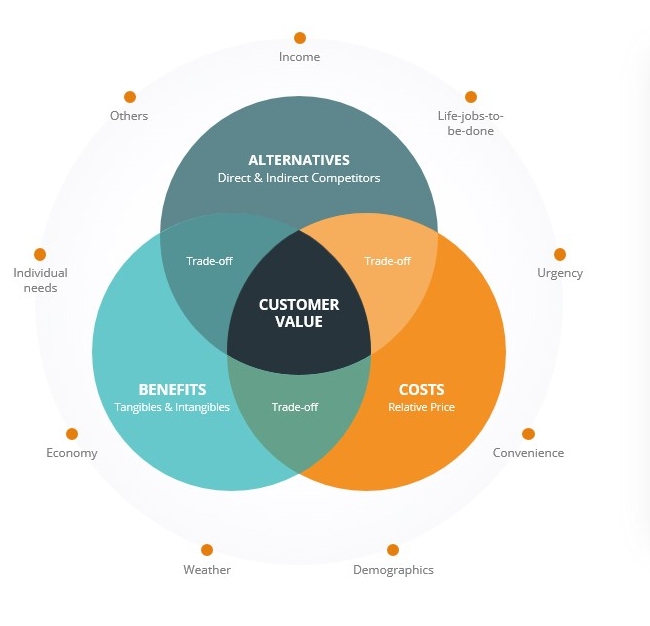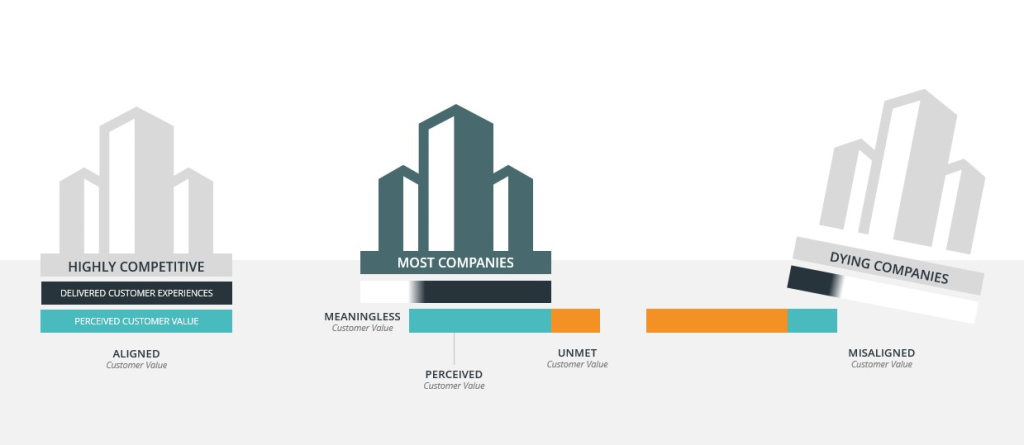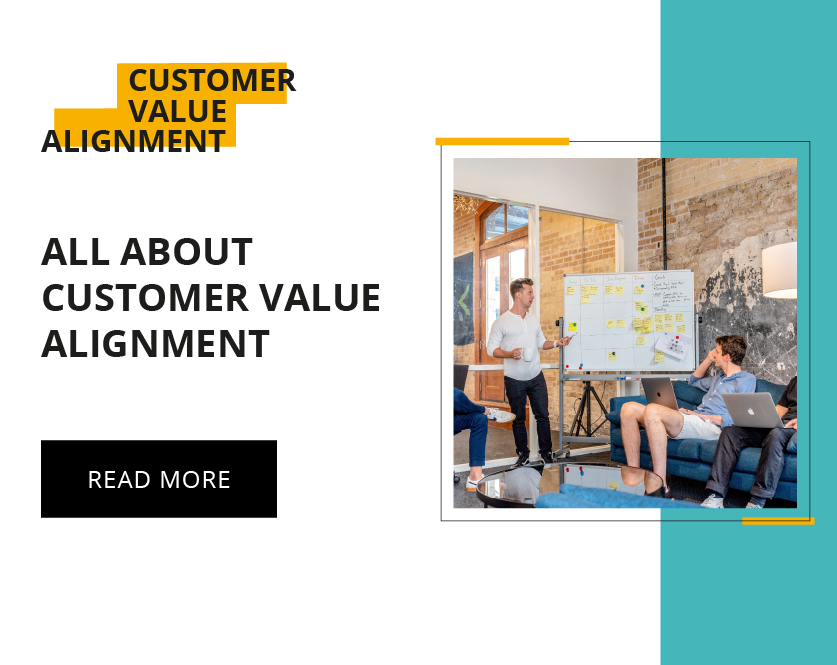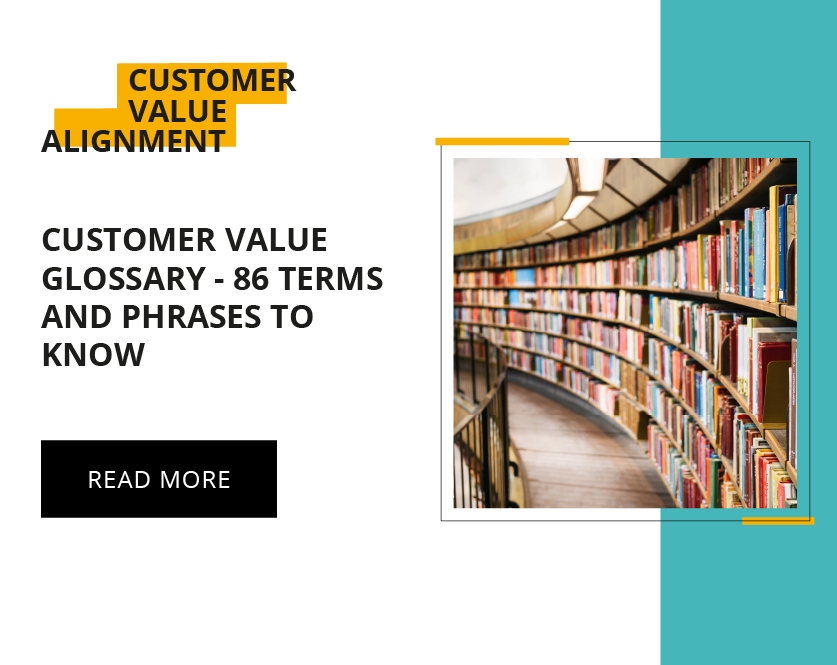What makes a customer buy, stay loyal, or churn, and more importantly, how do we measure it?
Researchers have tried to better understand how Customer Value is created since the 1970s, but no one in the market had come up with a good way to track it until recently: Customer Value Alignment (CVA).
In this article, we’ll show you how Customer Value Alignment solves the measurement problem and gives you a clear strategic path to creating value for your customers.
What is Customer Value Alignment?
To understand what Customer Value Alignment can do, you first have to understand Customer Value (CV).
Customer Value as a concept was ahead of its time for its ability to comprehensively define how customers choose one company’s offer over another.
The technology of the day couldn’t do it justice, but advancements in both technology and methodology have given Customer Value a new lease on life.
“Customer Value is defined as the trade-off between benefits and costs perceived by the customer when they compare a company’s offering to its market alternatives.”

*The outer ring is made up of external factors that neither the company nor the customer control. They are not directly related to the cost-benefit analysis, but still have a measurable impact on the decision.
Let’s break down each of the major sections; Cost, Benefits, and Alternatives.
- Cost – Relative Price
Cost is the currency that customers exchange for benefits. It is best to track ‘relative’ price as opposed to ‘absolute’ price. Relative price is the price when compared to another product or service with similar or equal benefits. - Benefits – Tangible and Intangible
- Benefits are what you receive in exchange for a cost. They can be tangible or intangible.
- Tangible benefits are those that are easy to explain because they have a concrete component to them.
They are relational factors such as the store or website, customer service, cleanliness, and effort, or they are related to the goods, such as quality. These drivers tend to deliver the most valuable insights into how the operational side of the business affects customers’ perception of value.
Another framework we use to measure and classify tangible benefits is the Marketing Mix, or the 5 P’s (People, Product, Place, Promotion, Price). - Intangible benefits are not easy to explain because they are abstract and are difficult to present simply.
They are behavioral elements such as Social Proof and Brand Identification.
These elements are notoriously hard to measure at scale and are usually reserved for data scientists or behavioral economists to research and map out qualitatively with focus groups or in-depth interviews.
These drivers tend to have a greater impact on the Marketing/branding side of the business.
- Tangible benefits are those that are easy to explain because they have a concrete component to them.
- Benefits are what you receive in exchange for a cost. They can be tangible or intangible.
- Alternatives – Direct and indirect competitors, substitute
- Customers always consider other available options prior to making a choice. ‘Alternatives’ refers to all the players in the market that could affect customers’ perception of the value of the products or services offered by a company.
- Direct competitors offer the same solution to the same problem.
- Indirect competitors offer a different solution to the same problem.
- Substitutes are solutions that have not previously been used to solve that problem.
- Customers always consider other available options prior to making a choice. ‘Alternatives’ refers to all the players in the market that could affect customers’ perception of the value of the products or services offered by a company.
Customer Value is the ultimate factor behind a customer’s decision to buy or stay loyal to your business. Once they’ve accepted the trade-offs, that’s the moment their money effectively changes hands.
That means it’s tied to the revenue of your business and thus a direct representation of your overall success or failure.
Why Measuring Customer Value Didn’t Work in the Past
The Customer Value concept is simple enough but measuring and executing it properly is another story. While Customer Value always had the potential to be a unifying, strategic overview for a company, there were two major problems that made it more challenging than it was worth:
- When it was created, Customer Value was computationally intractable, especially at the level of customer verbatims. There were too many potential variables that needed to be tracked, and this was further complicated by the nuances of natural language. The processing power to compute all the necessary data also didn’t exist yet.
- Tracking Customer Value in verbatims from qualitative studies manually would have cost unsustainable amounts of human time and effort. It also would have meant a significant lag time between gathering results and applying them. In today’s fast-paced economy, where customer preferences change rapidly, that lag time can make insights obsolete before they can be used.
Solution: Customer Value Alignment
To solve these problems, we first had to create the necessary technology to gather insights at scale. Then we had to create a system around that technology to operationalize those insights.
The Technology: LUCI
The first and biggest hurdle to solving Customer Value was coming up with more computing power. Like many industries, this was jumpstarted with the help of AI, specifically Natural Language Processors (NLPs).
NLPs are AI trained to recognize, classify, and reproduce human language. Our AI, LUCI is a specialized conversational NLP, able to efficiently track, classify, and analyze numerous variables in customer verbatims by having dynamic dialogues with customers.
With LUCI, customers are free to talk about what matters most to their purchase decisions while she nudges the conversation to extract the most impactful perceptions behind their purchase decisions.
Any factors that impact their decision will occur naturally in the results, whether that is perceptions of cost, benefits, alternatives, competitors, or other external factors.
With that technological hurdle overcome, the issues of cost and value effectively solved themselves.
The only thing left was to put them into a system that made the resulting strategic insights as accessible and as actionable as possible.
The System: Customer Value Alignment
Customer Value Alignment is the process of closing the gap between what a business offers, and the value customers perceive from that business.
In other words, it can be used to understand all of the Perceived Benefits, Costs, and Market Alternatives that customers perceive and how this formulates their decisions.
This gives you a full understanding of their conclusion of worth, the most important moment in the customer’s buying process.
Most operational companies have some degree of alignment with their customers already. Realistically, no company can be in perfect alignment, but the goal of CVA is to push your company as close as possible to the ideal state of 100% alignment.

On either side of the “Aligned” value is “Meaningless” and “Unmet” value. “Meaningless” represents things your company does that don’t matter to customers, and are most likely a waste of time, money, and resources. Meanwhile “Unmet” represents things customers want, but you either don’t offer or you’re getting them wrong. These are usually innovation opportunities or things you can improve on.
Too much of either Unmet or Meaningless value can cause an imbalance that will inevitably lead to the business failing.
Customer Value Alignment can identify these problems while also giving you a clear strategic path to solving them.
The Customer Value Alignment Cycle
Putting your insights into a system that’s easy to manage and interpret allows you to scale them out to your whole company and is even more important than the tech behind it.
The Customer Value Alignment Cycle breaks this process into 3 steps:

- Track Value
- Worthix’s AI, LUCI, uses a conversation-based framework to explore what really leads the customer to conclude that doing business with you is “worth it”. She has 2-minute conversations with your customers, in-depth, at scale, and at any part of their journey.
- Find Actionability
- Blend conversations results with metadata, test hypotheses and find actionable opportunities. Worthix automatically looks for correlations between the conversation themes and your respondents’ metadata such as amount spent, age, gender, location, purchase, journey moment etc. Then it highlights business opportunities, customer profiles, and relevant segments so you can precisely act where you’re more likely to have success.
- Co-create Innovation
- Worthix tells you which experiences should be improved and identifies opportunities for innovation. It then allows you to invite your customers to co-create solutions before you invest money and other resources
- (Repeat)
- The most important part of the CVA Cycle is that it’s always on, continuously gathering insights so you can react to changes in customer perceptions as they happen. Keeping your finger on the pulse of your customers is key to staying relevant in this fast-changing world.
Customer Value Alignment is the answer to sustained growth
Customer Value Alignment is the only measurement system that enables businesses to continuously understand how and where they are creating value for their customers.
Even the largest enterprise businesses are susceptible to disruption and the increasing speed of change.
Customer Value Alignment is how even giants can stay nimble with strategies that are always on the cutting edge of customer perceptions.
It’s not just valuable at the C-suite level, either. Among the greatest benefits of CVA is its ability to unite siloed departments around a single measurement, even in the largest organizations.
There’s no team that wouldn’t benefit from a unified, high-level strategic view of the customer, and the faster you can formulate customer-centric strategies, the better you can serve your customers.
Learn more about how the Customer Value Alignment Cycle works in the next article, and how we take it even further with the Customer Value SWOT analysis.





